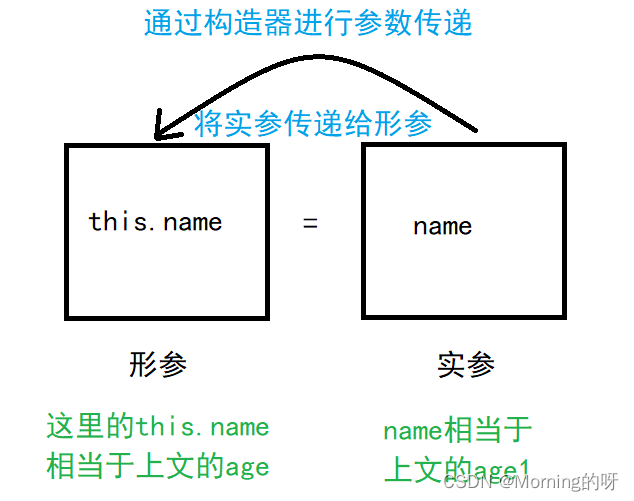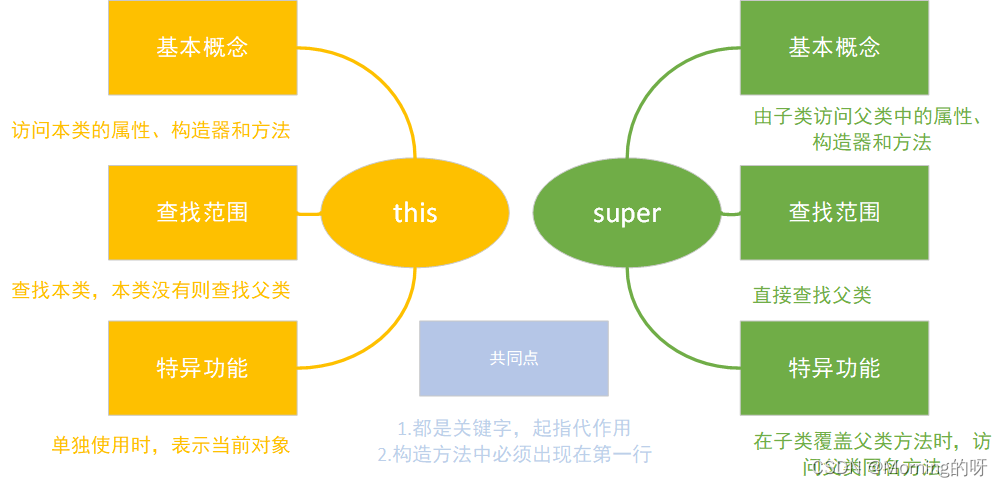Java Class08
this
this用于代表当前对象,通常用于构造器中进行参数传递
this可以访问当前类的属性、构造器和方法
访问属性
public class Test {
//访问属性
private int age;
private String name;
public Test(){
//非默认构造器
}
//未使用this关键字
public Test(int age1){
//将获取的实参传递给形参
age=age1;
}
//使用this关键字
public Test(String name){
//将获取的实参传递给形参
this.name=name;
}
}

访问构造器
public class B {
private int age;//初始化age
public B(){
//定义默认构造器
System.out.println("B");
}
public B(int age){
this();//调用构造器
System.out.println("B+");
}
public static void main(String[] args) {
B b=new B(100);
}
}
输出顺序是先B后B+
访问方法
public class Person3 {
String name;//定义属性name
int age;//定义属性age
String sex;//定义属性sex
public Person3(){
//定义无参构造器
System.out.println("无参构造器被调用");
sex="Male";
System.out.println("name="+name+"age="+age+"sex="+sex);
}
public Person3(String theName){
//定义含参构造器
this();//调用类下无参构造器
System.out.println("含参构造器被调用");
name=theName;
System.out.println("name="+name+"age="+age+"sex="+sex);
}
public Person3(String theName,int theAge){
//定义含参构造器
this(theName);//调用类下含参构造器
System.out.println("含参构造器被调用");
age=theAge;
System.out.println("name="+name+"age="+age+"sex="+sex);
}
public static void main(String args[]){
Person p=new Person("Mike",20);
}
}
在这里this关键字用于调用不同的构造器,调用顺序是方法自下而上的调用
super
super关键字用于对父类的属性、构造器和方法进行查找
调用属性
public class People {
public int age;
private String name;
public People(){
}
public People(int age){
this.age=age;
}
}
public class Student extends People{
public Student(){
}
public Student(int age){
super.age=age;
}
public void method(int age){
}
public static void main(String[] args) {
Student student=new Student();
}
}
在子类通过super关键字调用的时候,可以直接使用super.属性的方法进行调用,与this关键字类似
调用构造器
public class People {
public int age;
private String name;
public People(){
}
public People(int age){
this.age=age;
}
public class Student extends People{
public Student(){
}
public Student(int age){
super(age);
this.age=age;
}
public void method(int age){
}
public static void main(String[] args) {
Student student=new Student();
}
}
super和this关键字一样,在使用的时候必须在方法内的第一行
调用方法
public class People {
public int age;
private String name;
public People(){
}
public People(int age){
this.age=age;
}
public void method(){
System.out.println("Method");
}
}
public class Student extends People{
public Student(){
}
public Student(int age){
super.age=age;
}
public void method(){
super.method();
System.out.println("Method2");
}
public static void main(String[] args) {
Student student=new Student();
student.method();
}
}
this与super的异同点

初始化块
初始化块实际上就是规定一部分区域,在内部完成一些初始化操作等内容
public class A{
private int age;
{
System.out.println("1");
}
public A(){
System.out.println("2");
}
public void demo(){
System.out.println("3");
}
public static void main(String args[]){
A a=new A();
a.demo();
}
}
输出1、2、3
从上可以得出,初始化块是最先执行的内容,然后再实例化的过程中调用了默认构造器,所以会调用构造器方法,而成员方法只有在调用方法时才会被使用
继承对构造器的影响
如果在继承中使用构造器,会先调用父类的构造器,然后在调用子类的
Father类
public class Father {
public Father(){
System.out.println("Father");
}
}
Son类
public class Son extends Father{
public Son(){
System.out.println("Son");
}
public static void main(String[] args) {
Son son=new Son();
}
}

这里就是先调用Father的无参构造器,再调用Son的无参构造器